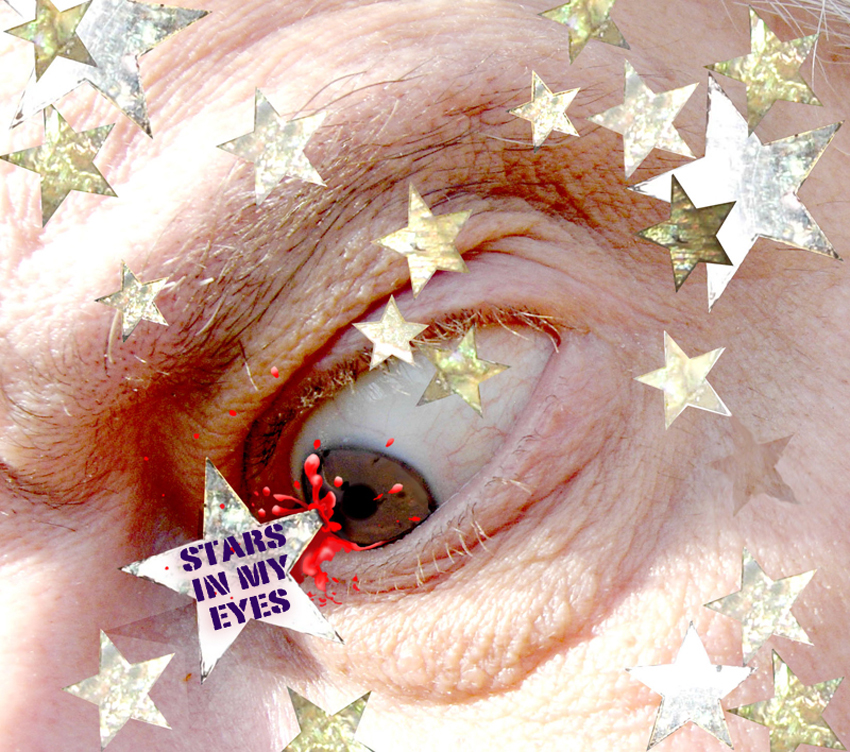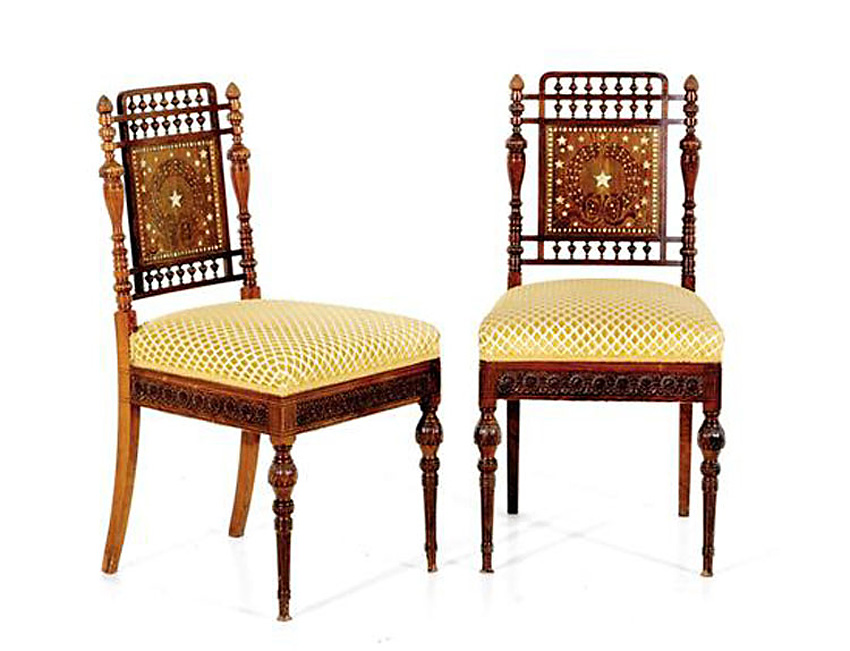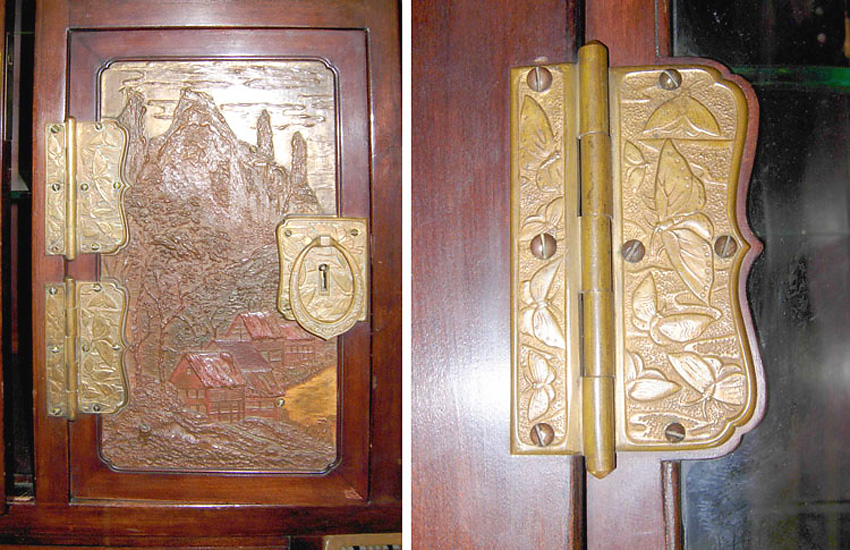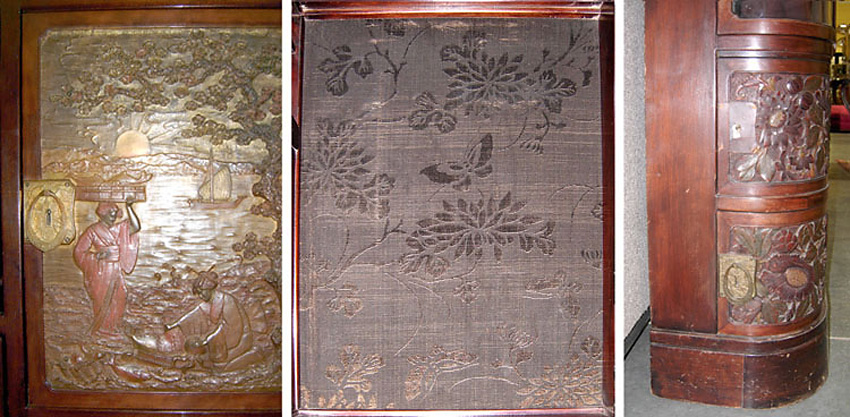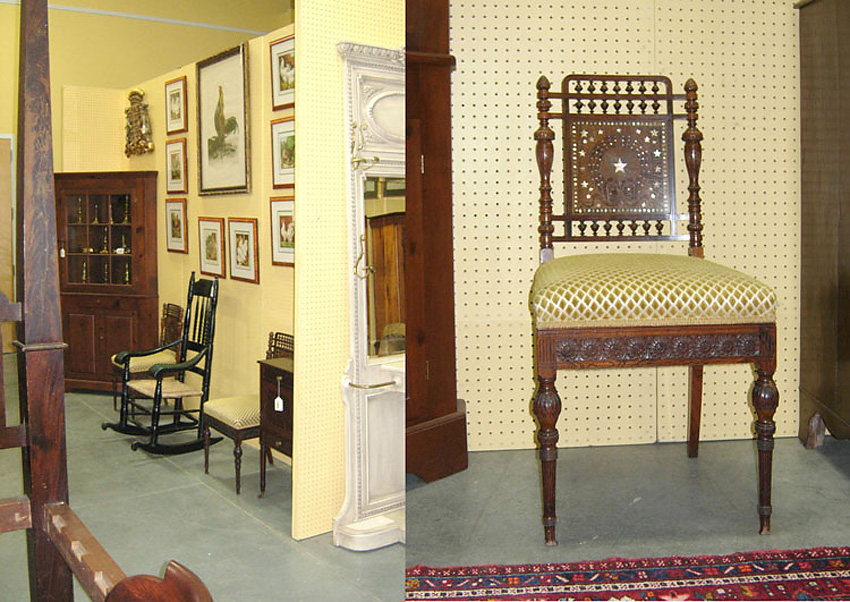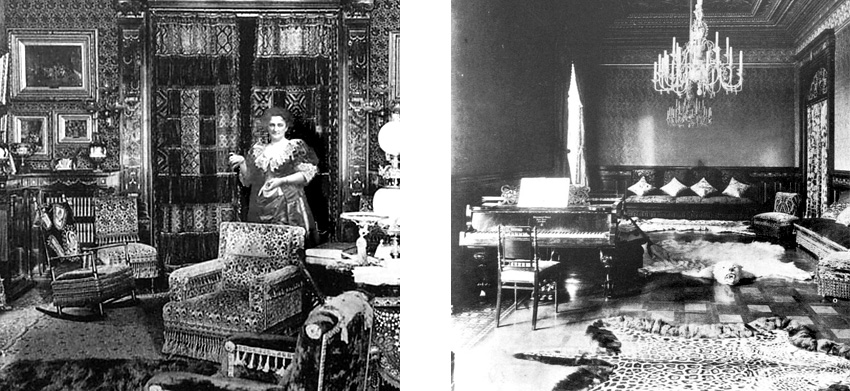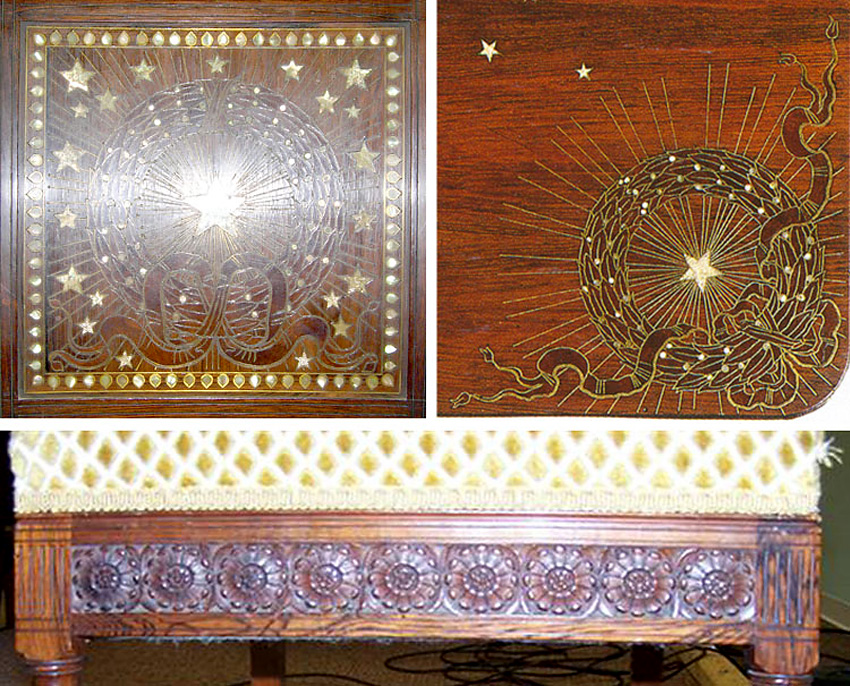|
I don’t read the antiques trade papers anymore because I figure once an object I find interesting appears in an auction ad, it will have been spotted by pragmatic dealers and/or collectors with the means and methods to pay a big price and still turn a profit. I get too bollocksed up with the excitement of the discovery and the intellectual exercise to compete in any realistic way, so I rely on serendipity instead of concerted effort. A month ago a brochure from Charlton Hall Auctions, which has steadfastly kept me on their mailing list even though I have never bought anything from them, arrived in my post box. The auction title was “From Museum Vaults” and the sale featured swords, guns, export porcelain, Meissen, Sévres, and lots of “Louis XVI style” furniture. As I was reaching toward the wastebasket to toss it out, a photo of an “Art Nouveau cherry and bronze plaque inset étagère, probably American, late nineteenth century” caught my eye. I am seldom attracted to Art Nouveau’s facile swirls, but I wondered what American company could have made such a French-looking piece so I snatched the folder out of the trash, intending to look up the cabinet online later. The brochure got buried under more important papers like the 20% off coupons from Bed Bath & Beyond and Petco.
I didn’t notice the flyer again until I needed a coupon to get a new 40-pound bag of dog food. The announcement didn’t give lot numbers so finding the cabinet meant scrolling through all the lots. Dozens of ivory-handled swords, flintlock muskets, ormolu mantel clocks, crystal chandeliers, diamonds, pearls, emeralds, and rubies flickered past as I scrolled down the pages until one lot stopped me: Sale 252 Lot 429 Pair Continental style silver gilt side chairs circa 1900 solid pierced crest over upholstered back and cushioned seat, on ring-turned tapered legs with ankle collars. Provenance: Property deaccessioned from the Centennial Museum at the University of Texas at El Paso to benefit the Museum Collections Fund. (Accession #69.26.349 and 69.26.350)
I snickered archly, wondering how anyone could mistake such a well-known Herter Brothers chair design even though the silver gilt, should inspection prove it to be original, is highly unusual if not unique. Everyone knows about the gilded chairs Herter made for the Vanderbilt drawing room, but those are gold, not silver. I started scrolling again while entertaining the idea that, since the chairs weren’t photographed in any advertisements, those who scour the Bee and the Digest might miss them. After lots and lots of lace fans, Chinese export platters and plates, sterling teapots and fish forks, Fabergé flowers and not-so-Fabergé flowers, Louis-style vitrines and bombe bureaus, Meissen figurines and palm-tree pillows, I got to the cabinet: Sale 252 Lot 957 Art Nouveau carved cherry and bronze-mounted étagère possibly French, late 19th century tiered top with square post-and-rail gallery above asymmetrical arrangement of glazed doors, compartments, doors with decorated bronze panels and relief-carved doors, on straight molded base. Provenance: Property deaccessioned from the Centennial Museum at the University of Texas at El Paso to benefit the Museum Collections Fund. (Accession #69.26.419) Condition: Repairs to gallery, very minor paint losses to bronze panels, finish losses and scratches to base molding and shelf surfaces, one bronze escutcheon with bail handle is missing, overall good condition with minor imperfections expected with age.
I hardly glanced at it because the very next lot jumped out at me: Sale 252 Lot 958 Pair Victorian Aesthetic Movement rosewood and mother-of-pearl side chairs last quarter 19th century tablet back inlaid with wreath and stars bordered by tiers of urn-form finials, flanked by turned legs, upholstered seat on rails carved with rosettes on fluted and collared legs. Provenance: Property deaccessioned from the Centennial Museum at the University of Texas at El Paso to benefit the Museum Collections Fund. (Accession #69.26.398 and 69.26.399) Literature: Similar examples can be found in HERTER BROTHERS, FURNITURE AND INTERIORS FOR A GILDED AGE, by Katherine S. Howe et al Condition: Front feet are chipped, otherwise good condition with minor scuffs and scratches consistent with age.
I immediately recognized another Herter design, but the backs of the chairs I remembered had panels with wood inlays of Aesthetic movement flowers. These chairs had mother-of-pearl stars and laurel wreaths delineated with brass wires, which brought to my mind one of the most spectacular Herter pieces known to exist: the William H. Vanderbilt library table! That monumental table (on display at the Metropolitan Museum of Art for decades) set the theme for a library in what is perhaps the best documented, most highly praised Herter commission.
|
||
 |
Vanderbilt also had Herter interiors in his earlier house at 459 Fifth Avenue, but we have less documentation for those rooms than we do for his magnum opus at 640 Fifth Avenue, which he preserved for the ages with the ample illustrations in Mr. Vanderbilt’s House and Collection by Edward Strahan (Boston, 1883–84). The house was also featured in photogravures that appeared in Artistic Houses (New York, 1883–84). I studied grainy reproductions of the original photographs to see if I could spot the chairs in the overwrought library. Finally I spotted what looked like one of the legs of one of the chairs projecting from a bay window. I was using In Pursuit of Beauty: Americans and the Aesthetic Movement (New York, 1986), where the library photo appears across the page from a full-page detail of another Vanderbilt interior, the Japanese Parlor. |
|
|
I have always coveted the radical armchairs made for that parlor, but I ignored the room as a whole because I thought it was overdone to the point of being ugly. As I was revisiting Herter’s strange and raucous interpretations of Japanese design, I noticed that the cabinets along the wall matched the Art Nouveau cabinet in the auction. That clinched a Vanderbilt connection for all three lots for me. There had been a “continental” ivory inlaid cabinet in Mrs. Vanderbilt’s bedroom, so I thought maybe even the Collinson & Lock cabinet (lot 668), also deaccessioned from the Texas museum, could have been from the Fifth Avenue house but I quickly forgot about the British piece in my excitement over the Herter pieces. 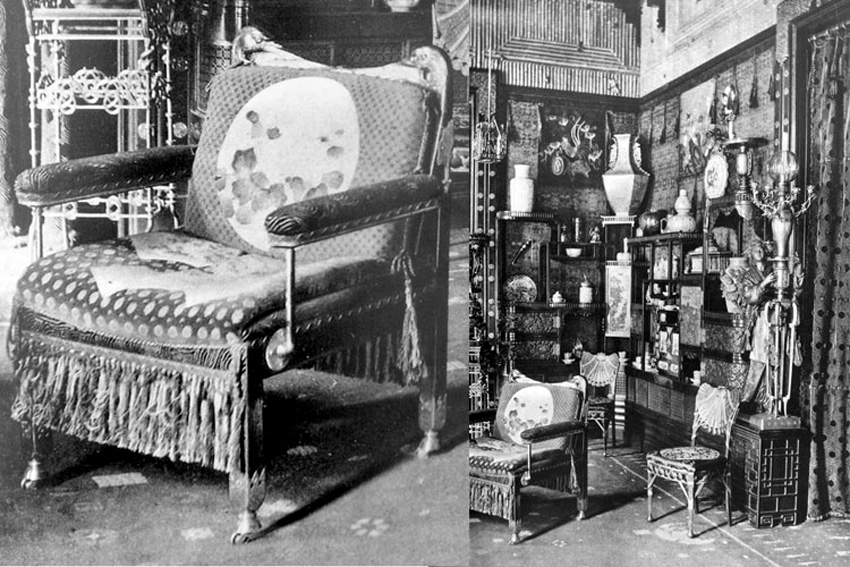
I began to obsess about why the Centennial Museum didn’t seem to know what these pieces were and who among those who knew all about Herter would happen upon this sale. I went to the museum’s website, which set me straight about why the Herter was being sold—it was a part of a huge gift of objects that are unrelated to the museum’s mission: “The Museum and Gardens are part of the University of Texas at El Paso, and also serve the binational community of the Chihuahuan Desert region; the Museum was established in 1936, and the Gardens were dedicated in 1999. The Museum’s permanent exhibits focus on the natural and cultural history of the Chihuahuan Desert region, the largest desert in North America, which extends from central New Mexico deep into Mexico. The extensive stored collections of the Centennial are available for scholarly research. In the temporary galleries the Museum presents a wide range of exhibits on themes related to border life and culture, both natural and human.” I then sent out some carefully worded “feeler” e-mails to dealers and collectors who would have been most likely to have studied the trade papers and made the same discovery I did. Just one old friend responded, and she wrote that she was not convinced of my Herter/Vanderbilt attribution. In the old days, I would have been able to have a frank, confidential discussion about the situation with the late Catherine Voorsanger, who was a curator at the Metropolitan Museum of Art and a contributor to both the 1994 Herter catalogue and In Pursuit of Beauty. But I suspected that someone like Margot Johnson would have alerted curator Alice Frelinghuysen. Finally, an elegant Herter collector with close ties to the Met responded by telephone to my tentative e-mail. After much plotting and reviewing of prices realized for comparable Herter (I am of the opinion that there are no comparables for these unique pieces), I bought a cheap standby ticket to Columbia, South Carolina, with the admonition, “Do not let the cabinet and star chairs get away!” It was agreed that, though the silver on the other pair of chairs was sorta sexy, they were not worth going after for any significant money. I had not been in Columbia since I was drafted and survived basic training at Fort Jackson. It turns out that Charlton Hall Auctions is right next to the airport, and they had a deal with the nearby Country Inns & Suites, so I didn’t bother to rent a car when I arrived the Friday evening before the sale. Metropolis Columbia, the capitol of South Carolina, was only six miles away—I supposed it had changed since I was crawling in the sand under barbed wire among the scrub pines at the military base, but I was tired and decided to have dinner at a nearby restaurant. The choices—Shoney’s, Waffle House, and Lizard’s Thicket—were all across the highway from the inn. Unless the standard of good looking is quite different in the South, the diners at the Lizard must have been filling up hoping against hope that the restaurant motto, “Country cookin’ makes ya good lookin’” would come true real soon. I noticed a change in my gut, but not in my outward appearance.
The next morning an affable, thoroughly smoked woman commandeered the inn’s shuttle bus and with a Mapquest printout in hand set out to get me to the auction house on time. As often happens Mapquest’s directions were wrong, and we ended up in the parking lot of an aeronautics company. Employees outside taking a cigarette break told us to “follow the Mercedes.” Back in the opposite direction we went, down a road that didn’t look too promising because the gold-painted Charlton Hall building was hidden beyond a trailer park. My driver pulled up to the auction hall entrance into a very tight parking space that was rather too close to the white Mercedes and a black Cadillac Escalade.
Once inside, I first found the diminutive, silver chairs in the main selling room. They were what they were, although I had hoped to find evidence of the original upholstery. The yellow damask was old, but not the first as indicated by the way it covered the earlier silver leaf on the rails. Close inspection revealed a leaf festoon pattern under the silver and gesso, which may be the outline of wood inlay. Next I spotted the cabinet. Two things surprised me: Although the dimensions were given in the auction catalogue, its proportions were far more agreeable than the monumentality suggested by the photographs. No one was giving it even a passing glance as they shouldered past on their way to the cases glowing with sparkling jewelry and Judith Leiber minaudière.
The condition of the cabinet is unbelievably good. It retains the original silk brocade on the backs of the cubby holes, the polychrome bronze plaques retain their vibrant patinas, the unique butterfly hardware retains evidence of the original gold wash, and the colored varnishes on the wood are in good enough condition to be retained and polished to a high gloss. The delicate gallery at the top did have some minor damage, and one butterfly escutcheon and ring pull was missing. A friend wondered if the cabinet had been set on a base to bring it up to the height of tops of the other cabinets in the Vanderbilt room, so I asked one of the very attentive, polite auction house employees to pull it away from the wall so I could see the back, which gave no indication of being part of a larger piece. Had it been installed at a higher level, the brass grilles wouldn’t have lined up with others, which march around the perimeter of the parlor and appear to be part of some heating system. I was looking forward to documenting the process of bringing the piece back to life!
After searching high and low for the star chairs, I had to ask an assistant to point them out. They were placed in front of a yellow pegboard wall one either side of a “Southern painted great chair.” The catalogue photos don’t do the stunning lapidary carving and fine (apparently original) finish on the rosewood justice. Even though the inlaid wreaths and stars and the carved flowers match the Vanderbilt library decorations, one might wonder at the contrast between the massive table and the delicate chairs. My theory is that, although there was an incongruous (to our eyes) little Shaker rocker with arms pulled up near the huge table, the other seating pieces were heavy upholstered easy chairs, which could not be easily moved or used by a lady burdened with corseted, voluminous clothing—few American women in the Vanderbilt social set would have braved the unfettered, flowing gowns favored by some aesthetes in Britain’s middle class. Then, too, the Herters would have known Vanderbilt found the design acceptable because they had made a less exotic version for his house at 459 Fifth Avenue.
Since the silver chairs were to be auctioned late Saturday morning and the cabinet and star chairs were to be sold on Sunday afternoon, I trudged back along the highway past the gun and knife show billboard, the Lizard’s Thicket, and the Un Beso Dance Club to the inn. The dance club looked closed so I settled into one of the white rocking chairs lined up on the inn’s porch and watched duffel bag burdened, camouflaged soldiers bump in and out of the lobby. I wondered if “country cookin’” got them lookin’ the way they did.
|
||
|
1967
. |
2009
. |
|
 Growing up in Maine, I was exposed to some of the worst and the best of Herter at a tender age. Gustave Herter’s work for Portland’s Victoria Mansion (left and center) is the kind of stuff that gave the Victorian era a bad name while his brother Christian seems to have been responsible for refining the look of the firm’s work with Aesthetic Movement ideas embodied in the little masterpiece on the right. As the sales room seats filled up, attendants mounted a raised dais to man the banks of phones for the Saturday session. Over the decades since I spied a little black “Egyptian” cabinet with inlaid cranes and one of its four dog-head finials in a bag tied to a corner post in a field at a Kennebunk, Maine auction relatively near Portland’s Victoria Mansion (now the Morse-Libby House), I had been vaguely and unwittingly aware of both early ponderous and late delicate Herter furniture. By the time I moved to Philadelphia and began to specialize in the Arts and Crafts movement, I had met players like David Hanks, who would determine how museums collected nineteenth-century American decorative arts right up until the High Museum of Art auctioned off most of the Virginia Carroll Crawford Collection in 2005. Back in the early 1970s we all looked as if we had been brought up on Lizard’s food; this morning I studied all the faces in the audience as if I could recognize any of the now-hoary Herter junta. Since no one looked familiar, I imagined I’d be bidding against dozens of anonymous phone bidders. The first hundred or so lots included much fancy French furniture and porcelain, some of which the audience aggressively bid up to five figures: A Linke table (lot 309) went for $12,000, a pair of pseudo Sévres urns (lot 331) went for $25,000, and a monumental French urn (lot 302) with a clock set in its base brought $33,000. Was the economy in the South doing better than my Northern eyes could imagine?
There were no left bids on lot 429, but a few bidders in the audience evidently thought they might find a use for the amusing little “continental” chairs and threw up their paddles, getting the bidding started at $300; at $1,000 the bidding stalled and then the phones exploded as the attendants waved more than a dozen of the bright red cards they used to indicate bids. The bidders in the audience rolled their eyes in amazement as phone bidder number 893 nabbed the chairs for $17,000. At last I knew everyone who needed to know knew, so I left the auction and followed the breakdown lane back to free cookies at the Country Inn & Suites. I didn’t bid on the silver chairs because I thought 16,000 of the 17,000 dollars were for the Herter association only. They were too expensive to keep as an interesting anomaly and I knew of no museum that would want them just because of the Vanderbilt connection, especially when the conservation or removal of the silver leaf and new upholstery (Apparently the silver chairs went directly from the auction house to the Metropolitan Museum of Art’s conservation laboratory.) would add more thousands to their price. A week later I learned that all the usual suspects, among them David Scott Parker and Baltimore dealer Andrew Van Styn had made the same discovery as I had.
The next day the auction house was virtually empty as the one o’clock starting time approached. A Southern gentleman next to me told me that was usual for Charlton Hall because regulars knew how the day would proceed and they would come in for the sections that interested them: “Southern pottery is always offered at the end of the day.” The auctioneer started with lots 900 through 956, which were mostly silver and Chinese export porcelain. Once again there were no left bids on the cabinet (lot 957), and it started at the low estimate of $5,000. This time there were only two or three phone bidders and I was able to bid against them to get the cabinet for only $28,000. I didn’t have time to take a deep breath before lot 958 came up. There were no left bids on these chairs either, so it was the phones against me, and after about $50,000 it was just one phone bidder against me until I won them at $85,000. This time heads in the audience spun around like so many Regan MacNeils. There was much clapping and some of the auction assistants came up to shake my hand, even though a set of Fabergé silver flatware had brought $100,000 on Saturday and a jade Cartier clock would bring $100,000 later on Sunday. Of course $85,000 is not nothing but, as collectors of nineteenth-century American decorative arts know, $85,000 is next to nothing for Herter of this quality and provenance. The rather scary American Renaissance bed from Thurlow Lodge sold last January for $326,000 including premium, even though it had a good deal of restoration because it had been banged around as a movie prop for more than 60 years. The Charlton Hall Vanderbilt furniture is in amazingly good original condition. The condition of the library chairs is especially fine. Retail values bandied about before the auction were as much as $200,000 for each star chair and up to $600,000 for the cabinet, but the pieces are unlikely to be for sale again so such speculation is useless to those who track the market. I may never know exactly who else knew what when. As with the Vanderbilt columns now at the Met, power players often inveigle piker pickers to stay away from objects at auction, sometimes making promises that stop just short of forming a pool. But my guess is that everyone was so taken with a pair of Tiffanyish chairs going off at Rago at the same time that they weren’t doing due diligence (never thought of an alliteration I could resist). I gathered up my carry-on carpetbag and shuffled off along the highway to the airport, alarming a security guard as I climbed over the guardrail and walked through the scrub-pine-dotted sand bogs on my way up to the main entrance.
|
||
